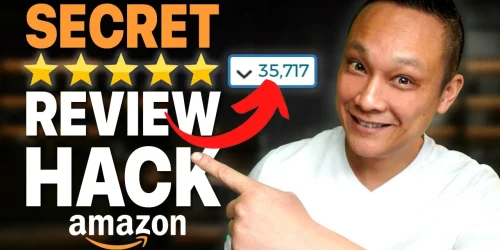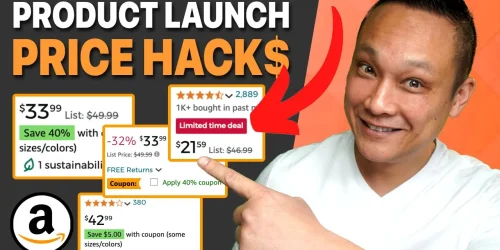How to Optimize Your Amazon Product Listing and Rank #1
A big misconception I see from new Amazon sellers is this: “If I list my product, grab a few reviews, I’m good.” Not quite. To consistently show up for the right buyers and actually convert them, you need a fully optimized listing—built on data, written for humans, and aligned with how Amazon’s search actually works.
Below is my step-by-step framework. Follow it, and you’ll give your listing the best shot at page-one rankings and higher conversions.
What We’ll Cover
- The two levers Amazon’s algorithm rewards (and how to control them)
- Step 1: Keyword research that actually matters on Amazon
- Step 2: Keyword integration across title, bullets, description & backend
- Step 3: Photos that sell (and why “nice shots” aren’t enough)
- A+ Content that indexes (and the common trap to avoid)
- Copy/paste templates, a checklist, and examples
- Pro tips that separate first-page winners from everyone else
How Amazon’s A9 Really Works (In Plain English)
Amazon’s A9 algorithm has one job: show what sells.
It prioritizes two things:
- Keyword Relevancy – Does your listing clearly match what the shopper searched for?
- Sales Performance – Does your product consistently generate sales?
If your listing nails both, Amazon rewards you with visibility.
You can’t directly control sales velocity on day one—but you can control relevancy by choosing and placing the right Amazon-native keywords (not Google keywords, not what “sounds good”).
Key mindset: Amazon searches are transactional (buyers ready to purchase), while Google searches are often informational. Use Amazon tools for Amazon SEO.
Step 1: Do Keyword Research the Right Way
You need two complementary keyword sets:
- Search-Volume Keywords – What shoppers type the most
- Tools: Helium 10 (Cerebro, Magnet)
- Sales-Volume Keywords – What actually converts into sales
- Tools: Sellerize (Keyword Hunter)
I use both—search volume to find demand, sales volume to win conversions. That combo accelerates rankings and reduces PPC waste.
Build Strategic Keyword Lists (Example: “Camping Tent Stakes”)
Create four lists:
- Main Keywords
- Ultra-relevant, buyer-intent terms (e.g., “screw-in tent stakes”)
- Relevant Keywords
- Broader or adjacent terms buyers use (e.g., “tent anchors,” “camping stakes”)
- Misspellings
- Non-autocorrected variants (collect and use strategically)
- Sales-Volume Keywords
- High-conversion phrases (from Sellerize/Keyword Hunter)
You’ll use these four lists throughout your listing and PPC.
Step 2: Integrate Keywords Into Your Listing (Without Keyword Stuffing)
Yes, you need to “feed” the algorithm—but a human makes the purchase. Your copy must be clear, scannable, and benefit-driven. Use each keyword once where it makes sense; repetition isn’t necessary for indexing.
Priority Placement Order
| Element | Why it Matters |
|---|---|
| Title | Shown in search; the biggest relevancy signal; drives click-through |
| Bullet Points | Communicate benefits over features; solve pain points; keep concise |
| Description | Support details, benefits, objections; add keywords naturally |
| Backend Terms | Capture leftover relevant terms you didn’t use in visible copy |
Tip: Keywords at the start of the title are weighted more. Lead with the shortest, most-relevant phrase.
Title Framework (Use This)
- [Main Keyword] | What it is | Key value/benefit | What’s included/spec | Differentiator
Bad Title Example
- “Tent Stakes Heavy Duty Camping Stakes Screw In Tent Stakes Tent Pegs for Camping Heavy Duty Tent Anchors Outdoor…”
Hard to read, repetitive, and stuffed.
Good Title Example
- “Screw-In Tent Stakes | Heavy-Duty Ground Anchors | Hold Fast in Sand, Soil & Wind | 20-Pack with Driver Bit | Reinforced, Bend-Resistant Design”
Clear. Skimmable. Benefit-first. No junk.
Formatting Tip: Use pipes ( | ) to separate phrases. Skip commas. Amazon adds your brand name automatically to the front.
Bullet Points That Sell (Not Just “List Stuff”)
- Lead with the problem → solution (benefits > features)
- Keep each bullet short and targeted (1–2 punchy sentences)
- Mirror shopper pains you found in reviews/competitor analysis
Weak Bullets:
- “High Quality Material.”
- “Great for Camping.”
- “Durable.”
Strong Bullets:
- Won’t Pull Out: Spiral design bites deep into soil/sand to keep tents and canopies locked down during gusts.
- No More Bent Stakes: Reinforced shaft resists bending and deformation—even in rocky terrain.
- Fast, Tool-Ready Install: Includes driver bit for quick install/removal using your drill.
Description
Use the description to expand on benefits, how it solves problems, what’s included, care/compatibility tips, and your differentiation story. Keep it skimmable with short paragraphs and occasional bold headings.
Backend Keywords (Generic Keywords)
- Drop in relevant terms you didn’t place up-front
- Separate terms cleanly (no need to repeat)
- According to the guidance referenced, you have space up to 25,500 characters (500 per line). Use wisely and stay relevant.
Do Not:
- Keyword-stuff the visible areas
- Repeat the same phrase endlessly
- Prioritize features over benefits
Step 3: Photos That Do the Selling for You
Most shoppers skim photos before reading. If your images don’t tell the story, you’ll lose the click—even with perfect keywords.
What Great Photo Sets Do
- Show, don’t tell the benefits (not just angles)
- Sequence the images to solve pains one by one
- Add lifestyle, in-use, feature callouts, and what’s-included images
- Make the main image pop in search: clean, true-to-product, and eye-catching
Common Pain Points (Tent Stakes Example) → Image Concepts
| Pain Point | Image Concept |
|---|---|
| Stakes pull out in wind | Visual of screw-in anchor holding firm in sand/soil with “Hold Fast” callout |
| Stakes bend/deform | Close-up of reinforced shaft vs. standard stake comparison |
| Hard to install | Drill-driver install shot + “Installs in Seconds” overlay |
| Unclear pack contents | Flat-lay: all components labeled (e.g., 20 stakes + driver bit) |
Hire Pros (or Use 3D Renders)
- Professional product photographers—not wedding/real-estate shooters
- If your product doesn’t photograph well (dark, reflective), 3D models can outperform photos: perfect lighting, colors, angles, and consistency.
Expect $300–$800 depending on scope. It pays for itself.
A+ Content (Brand Registered)
A+ lets you replace the plain description with visual modules. Use it to:
- Dive deeper into benefits and differentiation
- Compare against your other SKUs (comparison chart)
- Add more lifestyle and feature visuals
Pro Tip: Don’t make A+ all images. Search engines index text, not pictures. Include meaningful copy alongside visuals so Amazon and Google can index more queries.
What Not to Do (Costly Mistakes)
- Keyword stuffing titles/bullets → unreadable + lower conversions
- Repeating the same keyword endlessly → not needed for indexing
- Writing features-only copy → benefits sell
- Using generic photos that don’t communicate value
- Ignoring backend search terms for leftover relevant phrases
Optimization Workflow (Copy/Paste)
- Research
- Build Main, Relevant, Misspelling, and Sales-Volume keyword lists (Helium 10 + Sellerize).
- Draft
- Write a clean title (lead with main keyword).
- Create 5 bullets (pain → benefit).
- Draft a description that fills gaps and answers objections.
- Map Keywords
- Place main/relevant keywords in title & bullets.
- Support with description.
- Drop unused but relevant terms into backend.
- Images
- Plan shots to prove benefits.
- Produce with a pro or 3D modeling.
- Build an image order that tells a story.
- A+ Content (if eligible)
- Build modules with a balance of text + images.
- Publish → Measure
- Watch clicks, conversions, rank movement.
- Iterate copy/images based on real buyer behavior.
Title & Bullet Builder (Template)
Title Starter (swap in your details):
[Main Keyword] | What it is | Core Benefit | What’s Included/Spec | Differentiator
Bullet Starters:
- Solve the #1 Pain: State the frustration → show how you fix it
- Durability You Can Trust: What fails on competitors → your reinforced answer
- Fast Setup: How quickly + included tool/accessory
- Designed for Real Use: Where/when it shines (sand, wind, rocky soil)
- Everything Included: Pack size, bonus parts, storage
Priority Matrix (Where to Focus First)
| Area | Impact on Sales | Notes |
|---|---|---|
| Main Image | Very High | Must pop in search; true-to-product; clean and professional |
| Title | Very High | Lead with shortest, most relevant keyword; skimmable benefits |
| Bullets | High | Benefit-driven, concise, pain → solution |
| Gallery Images | Very High | Tell the value story visually; address pains |
| A+ Content | Medium–High | Add depth; include indexable text |
| Backend Keywords | Medium | Capture leftover relevance; stay on-topic |
Quick Reference: Do’s & Don’ts
Do
- Lead your title with the most relevant short keyword
- Write for humans first, algorithm second
- Focus bullets on problems solved
- Use images to prove benefits
- Place leftover relevant phrases in backend
Don’t
- Keyword-stuff or repeat phrases endlessly
- Use generic, “me too” bullets anyone could copy
- Ship low-effort photos; invest in visuals that sell
- Fill A+ with only images (add text to index)
Example: Before vs. After (Condensed)
| Section | Before (Weak) | After (Stronger) |
|---|---|---|
| Title | “Tent Stakes Heavy Duty Camping Tent Anchors Stakes for Camping Outdoor…” | “Screw-In Tent Stakes | Heavy-Duty Ground Anchors | Hold Fast in Sand & Soil | 20-Pack + Driver Bit | Reinforced” |
| Bullet 1 | “High quality material.” | “Won’t Pull Out: Spiral design bites deep, locking tents and canopies down in wind.” |
| Bullet 2 | “Durable and strong.” | “No More Bent Stakes: Reinforced shaft resists bending—even in rocky ground.” |
| Image | Plain white background product only | Lifestyle install sequence + callouts (“Installs in Seconds,” “Wind-Lock Spiral,” “Driver Bit Included”) |
Final Thoughts
Ranking #1 isn’t luck—it’s clarity and strategy:
- Use Amazon-native keyword data (search volume + sales volume).
- Write for humans, not bots: benefits over features.
- Let your photos do the heavy lifting.
- Use A+ to add depth (and indexable text).
- Keep iterating as you learn from real shoppers.
Dial this in, and you’ll move from “just listed” to “consistently converting”—the exact signal Amazon wants to reward.





